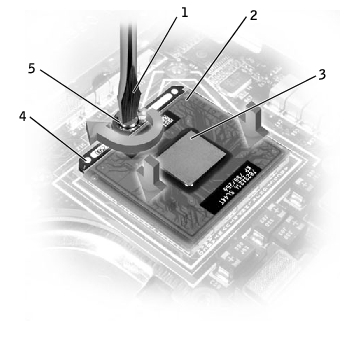Back to Contents Page
Dell™ Latitude™ C640
Service Manual
 |
NOTICE: Disconnect the computer and any attached devices from electrical
outlets, and remove any installed batteries.
|
 |
NOTICE: To avoid ESD, ground yourself by using a wrist grounding strap or
by touching an unpainted metal surface on the computer.
|
 |
NOTICE: To ensure proper thermal operation, always install a new,
compatible thermal cooling assembly along with a new microprocessor.
|
 |
NOTICE: Do not touch the processor die. To ensure proper seating of the
microprocessor in the socket, press down near the edges of the microprocessor
module (on the substrate surrounding the die) while turning the cam screw.
|
 |
NOTICE: To avoid damage to the microprocessor, hold the screwdriver so that
it is perpendicular to the microprocessor when turning the cam screw.
|

1 |
screwdriver (perpendicular to microprocessor) |
2 |
pin-1 corner |
3 |
processor die (do not touch) |
4 |
ZIF socket |
5 |
ZIF-socket cam screw |
- Remove the hard drive.
- Remove the keyboard.
 |
NOTICE: To ensure maximum cooling for the microprocessor, do not touch
the heat transfer areas on the microprocessor thermal cooling assembly. The
oils in your skin reduce the heat transfer capability of the thermal pads.
|
- Remove the microprocessor thermal cooling assembly.
 |
NOTICE: When removing the microprocessor module, pull the module
straight up. Be careful not to bend the pins on the microprocessor module.
|
- To loosen the ZIF socket, use a small, flat-blade screwdriver and rotate
the ZIF-socket cam screw counter-clockwise until it reaches the cam
stop.
The ZIF-socket cam screw secures the microprocessor to the system board. Take note of the arrow on the ZIF-socket cam screw.
- Use a microprocessor extraction tool to remove the microprocessor
module.
 |
NOTICE: Ensure that the cam lock is in the fully open position before seating
the microprocessor module. Seating the microprocessor module properly in the
ZIF socket does not require force.
|
 |
NOTICE: A microprocessor module that is not properly seated can result in
an intermittent connection, or permanent damage to the microprocessor and
ZIF socket.
|
- Align the pin-1 corner of the microprocessor module with the pin-1
corner of the ZIF socket, and insert the microprocessor module.
 |
NOTE: The pin-1 corner of the microprocessor module has a triangle that
aligns with a triangle (or missing hole) on the pin-1 corner of the ZIF
socket.
|
 |
NOTICE: You must position the microprocessor module correctly in the ZIF
socket to avoid permanent damage to the module and the socket.
|
When the microprocessor module is correctly seated, all four corners are aligned at the same height. If one or more corners of the module are higher than the others, the module is not seated correctly.
 |
NOTICE: Do not touch the processor dienear the edges of the microprocessor
module (on the substrate surrounding the die) while turning the cam screw.
|
- Press down on the edges of the microprocessor module and tighten the
ZIF socket by turning the cam screw clockwise.
- Install a new microprocessor thermal cooling assembly.
 |
NOTICE: To ensure proper thermal operation, always install a new,
compatible thermal cooling assembly along with a new microprocessor.
|
- Update the BIOS using the flash BIOS update floppy disk or CD. For
instructions on how to flash the BIOS, see "Flashing the BIOS."
Back to Contents Page














